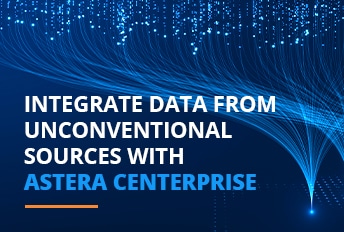
Unconventional Data Sources Supported by Astera Centerprise
Organizations need to leverage data coming in from various data sources, ranging from customer feedback forms to different digital marketing channels. With data pouring in from multiple channels, such as different flat file systems and web applications, most businesses don’t have a mechanism to integrate it. This can cause gaps in the analysis.
To make data integration more convenient for small and large-scale enterprises, Astera Centerprise supports a number of unconventional data sources. These include email sources, COBOL file formats, and EDI file formats to help organizations comply with governance standards.
Need to integrate data available in different formats? Here’s everything you need to know about using Astera Centerprise to connect to unconventional file sources to extract insights.
Supported Data Sources
Astera Centerprise comes with 40+ pre-built connectors, allowing organizations to integrate multi-touchpoint data and get a holistic view. The software also has built-in powerful transformations, data validation capabilities, and automation features to schedule tasks. These capabilities minimize the time required to download files and set up manual integration processes, increasing productivity across the board.
Here are some different types of data sources supported by Astera Centerprise:
- COBOL
- XML/JSON
- Report sources
- EDI formats (including X12, EDIFACT)
- ADO.Net Metadata Collection
- List FTP Directory Contents
- Multi-table query
- Virtual table query
Let’s discuss some use cases to understand how Astera Centerprise’s built-in connectors can help simplify your next project.
Data Mapping with the COBOL File Format
Despite being over 60 years old, COBOL is still used by organizations all over the world. The language is often used in transactional systems that handle thousands or even millions of entries a day, such as those built to support ATMs or claims filing in the insurance industry.
Even though many institutions rely on COBOL, integrating data directly from COBOL files can be a challenge. That said, Astera Centerprise’s out-of-the-box connector allows COBOL mapping and integration with other sources without any coding. Astera Centerprise also comes with a built-in data parser that automatically defines the layout of COBOL copybook files.
Integrating COBOL file format with multiple data sources in Astera Centerprise is as simple as:
- Dragging and dropping the COBOL source on the designer,
- Selecting the COBOL file you need to extract data from,
- And mapping it directly to the destination object.
Centerprise facilitates quick and easy COBOL data extraction and integration with any supported destination of your choice, including Excel, PDF, fixed-length file formats, and even popular database management systems, such as Amazon Redshift and Snowflake.
Using Astera Centerprise also ensures that organizations won’t have to replace their mainframe technology-based architecture. Instead, these organizations can feed their legacy data from COBOL and other file formats into their modern architecture and integrate it with data coming in from APIs or the cloud.
How to Use Email Source with Astera Centerprise
The email source object in Astera Centerprise can be used for a variety of use cases. For example:
- Automatically integrate files that you receive as email attachments.
- Send automated emails in real-time to stakeholders when certain actions are performed.

Specifying the folder in the email source
In the email source, you can specify the folder from which you want to process files. In addition, you can apply filters to email attachments so that only relevant files are processed. . In addition, you can apply filters to email attachments so that only relevant files are processed.
The email source object in Astera Centerprise can prove to be extremely useful in email data mining. Data from multiple emails can be mined and processed to gather information on trends, patterns, and behaviors surrounding a particular topic. For instance, an organization can use data mining to extract data from emails to understand the team’s sentiments regarding a new policy. Furthermore, they can use this information to decide whether any changes need to be introduced to the way policies are implemented.
Using the Report Source to Integrate Crucial Business Data
The Report Source in Astera Centerprise facilitates quick and easy data integration and allows you to extract key insights from your data. This is particularly important because reports often have large amounts of data that often goes unprocessed. Using Astera Centerprise’s Report Source, you can easily extract data from reports, use dozens of built-in transformations to enrich your data, and integrate it with data ingested from other sources to make key business decisions.
Say, for instance, your company’s finance team generates a report about monthly and quarterly expenditure by each department. To ensure that nothing’s amiss, you will need to integrate this report with the initial budgeting Excel sheet or database that you had created. Doing so will help you take a better look at your report with the right context and help you understand areas of improvement so that you can streamline and optimize your processes in the future to reduce overheads.
To use Astera Centerprise’s Report Source, all you need to do is drag and drop the source object on the designer and configure the object’s properties, as shown in the image below. First, you will have to provide the location of the report itself, and then you will provide the file path of the Report Model. Once you are done with this, all you need to do is click OK.
Providing the file path for both the report and the report model is enough to configure the Report Source in Astera Centerprise successfully. You can then connect the object to any transformation of your choice or map the data from your report directly to any supported destination.
Ease of Use with Astera Centerprise
As an enterprise-grade data integration tool, Astera Centerprise comes with automation features and point-and-click capabilities that can make your integration projects a breeze.
- The software’s parallel-processing engine allows you to integrate large volumes of data simultaneously.
- Built-in transformations simplify data manipulation and enrich data arriving from multiple touchpoints.
- Data quality rules ensure that you only use high-quality, error-free data in your reporting, business intelligence, and analytics. Ultimately, that means more effective insights that drive better business decisions.
Interested in learning more about Astera Centerprise and how it can help reduce your project delivery timelines? Get in touch with our team to view a demo or to discuss your use case.
 Astera AI Agent Builder - First Look Coming Soon!
Astera AI Agent Builder - First Look Coming Soon!

